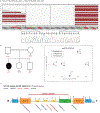Identification of a large homozygous VPS13C deletion in a patient with early-onset Parkinsonism
- PMID: 30452786
- PMCID: PMC6309582
- DOI: 10.1002/mds.27516
Identification of a large homozygous VPS13C deletion in a patient with early-onset Parkinsonism
Keywords: VPS13C; early-onset parkinsonism; genomic deletion; polyneuropathy.
Conflict of interest statement
Financial disclosure/conflict of interest:
The authors declare they have no conflict of interest.
Figures

References
-
- Schormair B, Kemlink D, Mollenhauer B, et al. Diagnostic exome sequencing in early-onset Parkinson’s disease confirms VPS13C as a rare cause of autosomal-recessive Parkinson’s disease. Clin Genet 2018;93(3):603–612. - PubMed
-
- Kaer K, Speek M. Retroelements in human disease. Gene 2013;518(2):231–241. - PubMed
Publication types
MeSH terms
Substances
Grants and funding
LinkOut - more resources
Full Text Sources

